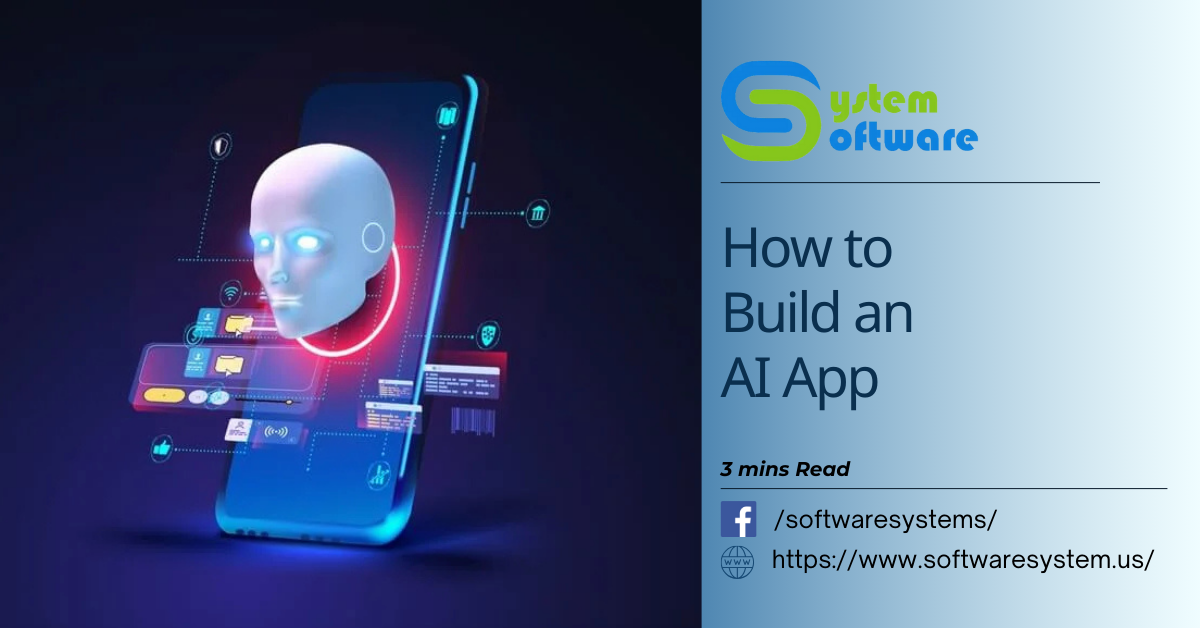Creating an AI app involves combining technology and strategy to solve specific problems, enhance user experiences, or improve business processes. Whether you’re a researcher, developer, or business owner, this guide from Software System, a technology services company, will walk you through the essential steps of building an AI App.
Table of Contents

Steps on How to Build an AI App
here are some of the considerations while building an artificial intelligence app
1. Identify the Problem and Set Goals
The foundation of any AI app is understanding the problem it aims to address. Define the purpose of the app and the benefits it will deliver. Questions to consider:
- What specific challenge will this app solve?
- How will the AI feature improve the process or outcome?
- What key results do you expect?
Establish clear Key Performance Indicators (KPIs) such as model accuracy, precision, recall, or fairness to measure success. Tools like Scrum can help set development milestones. At this stage, assess your resources, including team composition and infrastructure, to ensure you have the necessary support for development and deployment.
2. Collect and Prepare Data
Data is the backbone of any AI application. High-quality, well-prepared datasets are critical to building effective AI models. Follow these steps:
- Source Data: Use platforms like Common Crawl (for text data), Kaggle or AWS Data Exchange to find datasets suited to your project.
- Clean the Data: Remove duplicates, errors, and inconsistencies with tools such as OpenRefine or Tibco Clarity.
- Preprocess the Data: Apply transformations like normalization, integration, or reduction to refine the dataset.
- Wrangle the Data: Convert the cleaned and preprocessed data into a format optimized for model training.
Prioritizing data quality ensures that your AI model performs reliably in real-world scenarios.
3. Choose the Right Tools and Frameworks
Selecting the right tools is vital for developing and deploying your AI app. Popular frameworks include:
- TensorFlow: Ideal for image recognition, commercial AI apps, and large-scale projects.
- PyTorch: A favorite for academic and experimental work due to its flexibility.
- Google AutoML: Great for teams new to AI, offering user-friendly tools for custom model training.
Cloud platforms like Google Cloud AI, AWS SageMaker, and Azure Machine Learning provide robust environments for building and deploying AI models. Choose tools that align with your app’s goals and integrate seamlessly with your infrastructure.
4. Design and Train the AI Model
Building an AI model involves both designing its architecture and training it with data.
Training Approaches:
- Supervised Learning: Best for labeled data and clear outcomes (e.g., facial recognition).
- Unsupervised Learning: Ideal for uncovering patterns in unlabeled data (e.g., anomaly detection).
- Reinforcement Learning: Useful for decision-making tasks in dynamic environments (e.g., robotics, gaming).
Model Architectures:
- Convolutional Neural Networks (CNNs): Effective for image and pattern recognition tasks.
- Recurrent Neural Networks (RNNs): Suited for sequential data like time-series analysis and natural language processing.
- Generative Adversarial Networks (GANs): Create new, realistic data such as images or videos.
Prepare the data by splitting it into training, validation, and testing sets. Feature engineering ensures the data is optimized for pattern recognition. Use cross-validation and hyperparameter tuning to refine the model for optimal performance.
5. Test and Evaluate the Model
Testing ensures the AI model works effectively in real-world conditions. Use unseen test data to evaluate its performance against metrics like accuracy, precision, recall, or F1 score. Generative AI applications may also employ advanced techniques like embeddings and retrieval-augmented generation (RAG) to improve results.
6. Deploy and Monitor
Once the model passes testing, integrate it into your application and deploy it to production. Use tools like Docker and Kubernetes for containerization, and cloud platforms for hosting. Monitor the app post-deployment with tools like Prometheus or Grafana to track performance and detect issues.
See App Development Services at Software System.
Advanced Techniques for Generative AI
Generative AI requires specialized techniques to achieve high-quality outputs:
- Embeddings: Represent text or images as vectors to preserve semantic relationships, improving tasks like text generation or recommendation systems.
- Retrieval-Augmented Generation (RAG): Combines information retrieval with generative models to produce more accurate, context-aware results.
- Fine-tuning: Adjusts pre-trained models to adapt to specific tasks or domains, enhancing accuracy while minimizing training time and resource usage.
Conclusion
Building an AI app requires a structured approach, from defining clear goals to leveraging the right tools and frameworks. Whether you’re developing a general ai in mobile applications or a generative AI solution, success depends on high-quality data, well-defined objectives, and continuous refinement. By following these steps, you can create artificial intelligence in mobile app development that delivers tangible results and sets you apart in today’s competitive market.

